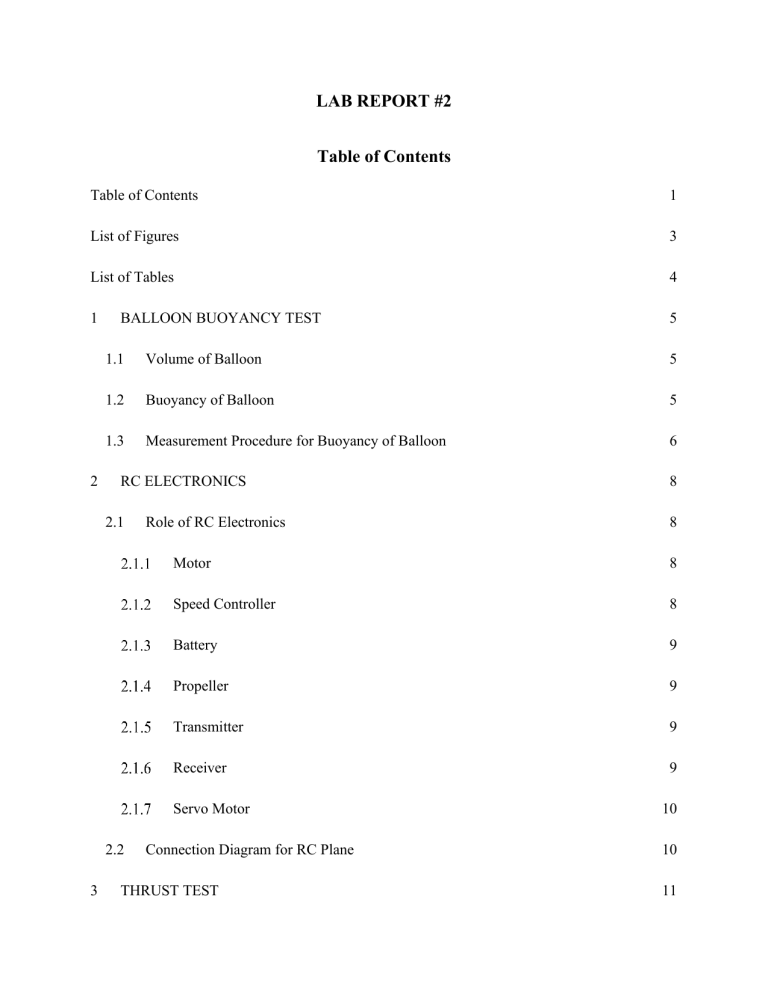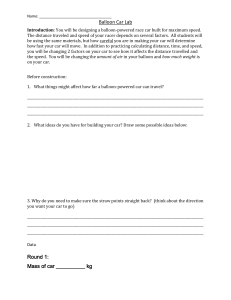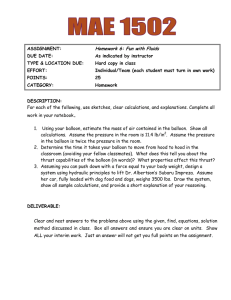
LAB REPORT #2 Table of Contents Table of Contents 1 List of Figures 3 List of Tables 4 1 5 2 BALLOON BUOYANCY TEST 1.1 Volume of Balloon 5 1.2 Buoyancy of Balloon 5 1.3 Measurement Procedure for Buoyancy of Balloon 6 RC ELECTRONICS 2.1 Role of RC Electronics 3 8 Motor 8 Speed Controller 8 Battery 9 Propeller 9 Transmitter 9 Receiver 9 Servo Motor 2.2 8 Connection Diagram for RC Plane THRUST TEST 10 10 11 3.1 3.2 4 Experimental Setup 11 Load Cell 11 Load Cell Amplifier 12 Wattmeter 12 Experimental Results References 12 14 List of Figures Figure 1. Connection Diagram of 4-channel RC Aircraft 10 Figure 2. Thrust Test Setup 11 List of Tables Table 1. Buoyancy Calculations 6 Table 2. Endurance Calculation 13 1 1.1 BALLOON BUOYANCY TEST Volume of Balloon Assuming the balloon to be ellipsoid, we can determine the volume using following formula [1]: 𝑽𝒐𝒍𝒖𝒎𝒆 = 𝑽 = 𝟒 𝝅𝒂𝒃𝒄 𝟑 Where a, b, and c are the principal axes of the ellipsoid. From the lab measurements, we know: 𝑎 = 𝑏 = 36 𝑐𝑚 𝑐 = 12 𝑐𝑚 4 => 𝑉 = 𝜋(36)(36)(12) 𝑐𝑚3 3 => 𝑉 = 65144.065 𝑐𝑚3 => 𝑽 = 𝟎. 𝟎𝟔𝟓𝟏 𝒎𝟑 1.2 Buoyancy of Balloon Buoyancy of the balloon can be calculated using the following formula [2]: 𝑩𝒖𝒐𝒚𝒂𝒏𝒄𝒚 𝑭𝒐𝒓𝒄𝒆 = 𝑭 = (𝝆𝒂𝒊𝒓 − 𝝆𝒉𝒆𝒍𝒊𝒖𝒎 )𝒈𝑽 Here, g is the gravitational acceleration and V is the volume of air displaced, which is given by the volume of the balloon (ellipsoid). We also know the densities of air and helium to be equal to 1.225 kg/m3 and 0.0851kg/m3 respectively. So, we can now determine the buoyancy force. 𝐹 = (1.225 − 0.0851)(9.8)(0.0651) 𝑁 => 𝑭 = 𝟎. 𝟕𝟑 𝑵 1.3 Measurement Procedure for Buoyancy of Balloon Archimedes' principle states that an object submerged in a fluid encounters a force which is equivalent to the weight of the fluid displaced by that object. Applying this principle to the case of the Helium balloon, we know that the balloon rises upwards when it is not tied to the ground. This happens because the buoyant force is in fact greater than the weight of the Helium-filled balloon. We can also say that the weight of the balloon must therefore be less than the weight of the volume of air it displaces. So, the net force acts in upwards direction and is given by the difference in weight between the balloon and the volume of air displaced by it. For theoretical calculations, we can use the formula used in the previous subsection to estimate the buoyancy force by finding the product of the gravitational acceleration, volume of air displaced and the net difference of density of air and helium. For actual measurement, in order to determine buoyancy force, we measure the weight of the balloon. The electronic scale is placed upside down in a glass container, and the balloon is placed inside the container, so that when the balloon makes contact with the scale, it registers the weight of the balloon. First the weight is recorded when the balloon is tied to a support on the ground, and then the weight is measured with the balloon untied. Finally, the two weights are compared. The difference of the two weights yields the buoyancy of the balloon. The experimental results are shown below: Table 1. Buoyancy Calculations Mass of Balloon (tied to the ground) 0.237 kg Mass of Balloon (untied) 0.31 kg Net Mass of Balloon 0.073 kg (0.073)(9.8) N Net Weight (mg) 0.715 N Finally, we can compare the experimental and theoretical results. 𝑇ℎ𝑒𝑜𝑟𝑒𝑡𝑖𝑐𝑎𝑙 𝐵𝑢𝑜𝑦𝑎𝑛𝑐𝑦 𝐹𝑡 = 0.73 𝑁 𝐸𝑥𝑝𝑒𝑟𝑖𝑚𝑒𝑛𝑡𝑎𝑙 𝐵𝑢𝑜𝑦𝑎𝑛𝑐𝑦 𝐹𝑥 = 0.715 𝑁 Clearly, the buoyancy determined experimentally and theoretically agree with each other. The error is found to be only 2%, which again validates that the results are correct. 2 2.1 RC ELECTRONICS Role of RC Electronics Radio control (RC) is the utilization of control signals sent by radio to distantly control a gadget. Instances of basic radio control frameworks incorporate carport entryway openers in which a little handheld radio transmitter opens entryways. Radio control is likewise utilized for control of model vehicles from a hand-held radio transmitter. A rapidly developing application is control of unmanned aerial vehicles (UAVs) for both civilian and military use. RC electronics include the following components: Motor The motor is the power plant of an RC plane. The motor is responsible for turning the propeller at high speeds to provide the necessary thrust to move it through the air. Two basic factors play a key role in the choice of motor, which are: • RPM • Power rating. The standard motors used in RC planes are brushless [3], which means they use AC current to work. This necessitates the use of the component detailed in the next subsection. Speed Controller Often abbreviated as the ESC, the Electronic Speed Controller converts the DC power coming from the battery to an AC current which is required by the motor. As mentioned already, brushless motors need AC current to work. Another role of the ESC is to convert battery voltage down to 5V which is what the receiver requires to run. The choice of ESC depends largely on the amperage rating, which needs to be in line with the number of amps the motor can use. Battery LiPo (Lithium Polymer) batteries are standard for RC planes [3]. The battery is responsible for providing the voltage which will be converted into AC current and then driving the motor. The battery is the heart of any device running RC electronics. In general, batteries have three main characteristics: voltage, amp capacity and discharge rate. Discharge rate tells us how much current the battery can supply. Propeller The propeller and the motor go hand in hand. The propellor is responsible for providing the thrust required to make an RC plane airborne. It is connected to the motor and is driven by the motor. Transmitter The transmitter is the component which gives a person the ability to control an RC airplane. It sends signals to the receiver which in turn gives specific instructions to the servos for operational activities of the RC plane. Most modern transmitters use a 2.4 Ghz frequency [3]. Transmitters can have different number of channels. Channels are basically the number of things which can be controlled by the transmitter. As an example, a three-channel transmitter only gives the ability to control three servos. Standard RC transmitters for RC planes have six channels. These channels are responsible for controlling the rudder, elevator, ailerons, motor, Aux 1, and Aux 2. Therefore, each channel effectively controls a singular servo motor. Receiver The RC component which goes into the aircraft and is responsible for controlling the servos and motor(s) is the receiver. It must have same frequency as the transmitter so that it can connect wirelessly with it. It must also have the same number of channels as the transmitter so that each individual servo/motor may be controlled. The receiver requires 5V to run. It is responsible for sending signals to the servos to turn them. Another key role of the receiver is to send a signal to the ESC to define the operating RPM of the motor. Servo Motor Servos are responsible for the desired movement of control surfaces. The servos are connected to the receiver. Each control surface requires a separate servo, and a separate channel on the receiver and transmitter for proper signal transmission. 2.2 Connection Diagram for RC Plane Following is a connection diagram of RC electronics for a typical 4-channel RC fixed-wing aircraft, assuming 4 servos and 1 brushless motor is being used. Figure 1. Connection Diagram of 4-channel RC Aircraft 3 3.1 THRUST TEST Experimental Setup The experimental setup for the thrust measurement test is depicted in the following figure: Figure 2. Thrust Test Setup Load Cell A load cell is a transducer which changes over mechanical power into a quantifiable electrical yield. Despite the fact that there are numerous assortments of power sensors, strain gauge load cells are the most ordinarily utilized sort. A wheat stone extension is a critical part of this load cell too, working with the strain gauge. A load cell works by changing over mechanical power into computerized values that can be perused and recorded. Load Cell Amplifier A load cell amplifier is a gadget that can increase the strength of signs emanating from a load cell, to make the force that is being detected readable. Some of the time, the signals delivered by the load cell can be weak and low strength signals may not work with specific components of the measuring system. The load cell amplifier settles this issue by taking the signal and afterward enhancing it, bringing about a higher strength yield signal. Wattmeter A device used for measuring electric power i.e., the supply rate of electrical energy in watts of a given circuit is called a Wattmeter. 3.2 Experimental Results We assume that the LiPo battery has average voltage of 3.7V/cell and the amp capacity of the 2 cell battery is 2200mAh. The three combinations tested were as follows: • Test Combination A: 1 Motor/Propeller + 3 Servo Motors • Test Combination B: 2 Motor/Propeller + 3 Servo Motors • Test Combination C: 3 Motor/Propeller + 3 Servo Motors The results of the experiment i.e., thrust and power were recorded for each test combination. From all available data, we then determined the endurance (in minutes) for each test combination. The formula used for the calculation of endurance is shown below [4]: 𝑬𝒏𝒅𝒖𝒓𝒂𝒏𝒄𝒆 = 𝒕(𝒉) = 𝑨𝒎𝒑 𝑪𝒂𝒑𝒂𝒄𝒊𝒕𝒚 (𝑨𝒉) ⁄𝑪𝒖𝒓𝒓𝒆𝒏𝒕 𝑫𝒓𝒂𝒘𝒏 (𝑨) The results of the experiment are summarized in the following table: Table 2. Endurance Calculation Test Current Thrust [gf] Power [W] Combination Endurance [min] Drawn (Amp) A 145.652 17.88 2.42 54.54 B 289.72 33.02 4.46 29.60 C 412.704 46.98 6.35 20.79 4 [1] References "Wikipedia," [Online]. Available: https://en.wikipedia.org/wiki/Ellipsoid. [Accessed 05 04 2021]. [2] "Stack Exchange," [Online]. Available: https://physics.stackexchange.com/questions/135151/how-to-calculate-the-buoyant-forceon-a-balloon-at-different-altitudes. [Accessed 2021]. [3] HavocRC, "Instructables," [Online]. Available: https://www.instructables.com/BeginnersGuide-to-Connecting-Your-RC-Plane-Electr/. [Accessed 2021]. [4] L. W. Traub, "Research Gate," [Online]. Available: https://www.researchgate.net/publication/269567470_Range_and_Endurance_Estimates_f or_Battery-Powered_Aircraft.




